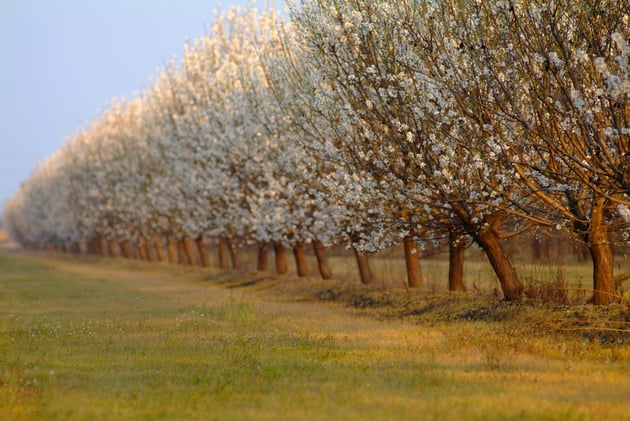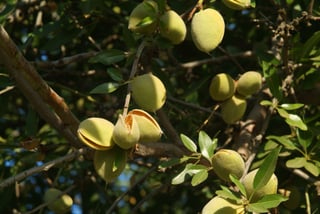Nuts About Ag Tires
Scrap yards, demolition sites, and remote logging locations are the images that first come to mind when we brag about a tire’s ability to work in the world’s harshest terrain and landscapes. What most people don’t think of are the lush almond orchards of California's Central Valley—where 80% of the world’s almonds are grown—however, the manner in which almonds are harvested creates unique challenges for the industry’s specialized machines, not to mention their tires.

Shaking it Up
Almond harvest begins with specialized machines called shakers, a unique piece of equipment designed to grab a tree by the trunk and literally shake the almonds out of it, leaving the ground covered in a blanket of nuts (as well as branches, twigs, and leaves) where they will remain for up to a week or more drying in the sun. Tires are asked to perform many functions in this first step of harvest, as they must display both durability and delicacy; the risk for punctures is high with the ground covered in debris and downtime is costly. Simultaneously, the tires must also tread lightly to avoid damaging the harvest or delicate soil.

(Fun fact: almonds, unlike many of their relatives in the prunus family like peaches, cherries, and plums, can be harvested in this manner thanks to their protective hulls and shells which keep the kernels from bruising.)
Sweep Up
Once the almonds have dried out, the mess on the orchard floor is cleaned up by another specialized machine, aptly named a sweeper. Sweepers use a combination of blowers and brooms to organize the mess on the ground into windrows. Although sweeping may seem the most benign of the tasks facing a tire at harvest, sweeper operators are subjected to environmental stresses ranging from heat to dust to noise. Any reduction to these stresses—like the comfort of a smooth ride and trust in a tire’s durability—will help minimize operator fatigue and increase efficiency.
Pick Up
The final stage of almond harvest is the collection of nuts. Here, harvesters and shuttle carts enter the fields to pick up the piles and bring almonds from the orchard to the elevator. Like any operation that involves moving heavy machinery on delicate soil, compaction is a concern—even more so when you consider all of the machinery that has already passed through the field during harvest. Soil health is paramount to almond growers, as the blowers found on sweepers can wreak havoc on unhealthy soil. Also, water has become both a high-profile topic and a high-cost input, making soil management a priority for growers.
From soup to nuts, growing and harvesting almonds ask a lot of tires and delivers surprisingly harsh terrain to work in (at least for tires). This February 16th, as we celebrate National Almond Day, take a minute to thank and recognize all the people, work, and engineering that goes into harvesting one of our favorite snacks.
From the Alliance 350 to the Alliance 550 MultiUse, our tires have proven their performance in the orchard. Contact your dealer to learn more about these (and all of our other) great tires!


